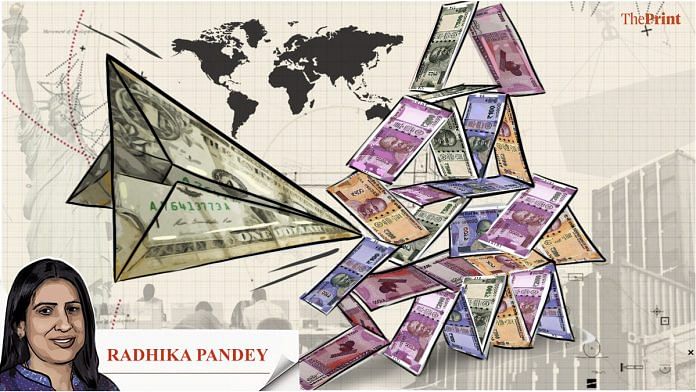The US Federal Reserve (Fed) raised its benchmark interest rate by 75 basis points in its June meeting to tame the 40-year high inflation. This is the most aggressive rate hike since 1994.
The Fed has indicated another 175 basis points hike this year. The aggressive rate hikes will dampen the demand and cause an economic slowdown. The Fed has strongly cut its growth projection for 2022 to 1.7 per cent from 2.8 per cent in March.
A sharp interest rate hike could accelerate the pace of capital outflows, weaken the rupee and increase the threat of imported inflation. Aggressive rate hikes could increase the possibility of a recession in the US. This could impact some of India’s export-oriented sectors.
Trigger for the 75 basis points rate hike
The Consumer Price Index (CPI) based inflation in the United States grew by 8.6 per cent year-on-year in May. In April, the CPI inflation had slowed from the highs of the previous month, triggering hopes that inflation may have peaked in the US.
Concerns were raised that aggressive rate hikes amid a slowing inflation could lead to increase in unemployment and lower wages. But the red hot inflation data for May raised the expectation of a 75 basis points hike by the Fed.
Also Read: What the RBI’s sharp interest rate hike portends for the Indian economy
Narrowing interest differential & faster pace of FII outflows
In the aftermath of the Covid shock, interest rates in the US moved down to near zero to support the economy. Low interest rates in the US and other advanced economies increased the interest differential and attracted dollar inflows in emerging markets such as India.
Since the second half of 2021, the Fed has indicated that it will reverse its ultra-accommodative monetary policy and shift its focus on inflation. Since January 2022, the US Fed has been raising rates. The rapid rise in global yields is narrowing the interest rate differential.
The 75 basis points hike in interest rate by the Fed will accelerate the pace of outflows by foreign institutional investors. So far in this calendar year, FIIs have pulled out more than USD 26 billion from debt and equity. The massive outflows is likely to continue with the Fed indicating more rate hikes this year.
Weaker rupee
The accelerated pace of outflow of foreign investments, coupled with elevated crude oil and commodity prices, could pose a downward pressure on the rupee. So far in this calendar year, the rupee has depreciated by 5 per cent against the dollar.
The depreciating trend in the Indian rupee is not out of sync with other emerging economies’ currencies. With continued uncertainty surrounding the war, capital is flowing to safe havens like the US, imparting strength to the dollar. The rupee has already breached the 78 per dollar mark despite aggressive central bank intervention.
A steady depreciation of the rupee and rise in global interest rates will increase the borrowing costs of companies accessing funds through the External Commercial Borrowing route. This may put brakes on overseas fund raising by companies.
In recent years, ECB is being increasingly used for financing new projects or modernisation of existing projects. Last two years, companies took advantage of the low interest regime and borrowed extensively from this route. Going forward, the attractiveness of this route will diminish with rise in interest rates and rupee depreciation.
Threat of imported inflation
A sustained weakness in the rupee will worsen the problem of imported inflation. Even if the global prices remain unchanged, a weaker rupee will increase the prices of imported inputs.
India is a big importer of crude oil. The depreciation of the rupee will make the imports of oil costlier. The rise in imports of oil is already putting pressure on India’s current account deficit. The current account deficit is expected to widen to 3 per cent in 2022-23.
Possibility of mild recession & implications for India
Recession risks have increased in the US post aggressive rate hikes. Signs of recession are visible through an inverted or a flatter yield curve.
In the normal course, the yield curve should be steep with yields rising with tenure. Typically, investors demand higher yields for locking their funds for longer tenures. But when they are worried about growth, they are willing to accept lower yields for longer tenures. Inverted yield curve also indicates uncertainty in the short run.
In the US, in recent months, there have been multiple episodes where the yield curve has inverted — meaning that the yield on short-term bonds has risen faster than those on long-term bonds. Research by the Federal Reserve Bank of Chicago shows that an inverted yield curve is typically associated with a recession in the near future.
Although it is too early to say whether the US economy would slip into a protracted recession, the possibility of a recession or a slowdown in growth will impact India’s export oriented sectors, particularly the IT sector.
The U.S contributes between 40-80 per cent of the revenues earned by the IT companies. A recession or a slowdown will impact the revenues of the Indian IT sector. A strategy to diversify exports could mitigate the adverse effect of a recession in the US.
In this uncertain scenario, India should avoid knee jerk policy responses and focus on strengthening its macro-fundamentals.
Radhika Pandey is a consultant at National Institute of Public Finance and Policy.
Views are personal.
Also Read: Chief economic adviser flags US rate hikes, oil prices as headwinds for Indian economy



